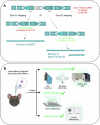Duchenne muscular dystrophy: recent insights in brain related comorbidities
- PMID: 39900900
- PMCID: PMC11790952
- DOI: 10.1038/s41467-025-56644-w
Duchenne muscular dystrophy: recent insights in brain related comorbidities
Abstract
Duchenne muscular dystrophy (DMD), the most common childhood muscular dystrophy, arises from DMD gene mutations, affecting the production of muscle dystrophin protein. Brain dystrophin-gene products are also transcribed via internal promoters. Their deficiency contributes to comorbidities, including intellectual disability ( ~ 22% of patients), autism ( ~ 6%) and attention deficit disorders ( ~ 18%), representing a major unmet need for patients and families. Thus, improvement of their diagnosis and treatment is needed. Dystrophic mouse models exhibit similar phenotypes, where genetic therapies restoring brain dystrophins improve their behaviour. This suggests that future genetic therapies could address both muscle and brain dysfunction in DMD patients.
© 2025. The Author(s).
Conflict of interest statement
Competing interests: The authors declare the following competing interests. F.M. has received grants, speaker, and consultancy honoraria from Sarepta Therapeutics, Roche, PTC Therapeutics, Dyne Therapeutics, and Pfizer. E.M. has received grants, speaker, and consultancy honoraria from Sarepta Therapeutics, Roche, Italfarmaco. Y.A. has received grants and consultancy honoraria from Nippon Shinyaku Co., Ltd. and grants from Shionogi & Co., Ltd. C.V., J.H., K.T. and A.G., declare no competing interests.
Figures





Similar articles
-
[Central nervous system involvements in Duchenne/Becker muscular dystrophy].No To Hattatsu. 2001 Nov;33(6):480-6. No To Hattatsu. 2001. PMID: 11725514 Japanese.
-
Dp71 and intellectual disability in Indonesian patients with Duchenne muscular dystrophy.PLoS One. 2022 Oct 31;17(10):e0276640. doi: 10.1371/journal.pone.0276640. eCollection 2022. PLoS One. 2022. PMID: 36315559 Free PMC article.
-
The X-linked Becker muscular dystrophy (bmx) mouse models Becker muscular dystrophy via deletion of murine dystrophin exons 45-47.J Cachexia Sarcopenia Muscle. 2023 Apr;14(2):940-954. doi: 10.1002/jcsm.13171. Epub 2023 Jan 11. J Cachexia Sarcopenia Muscle. 2023. PMID: 36628607 Free PMC article.
-
Retinal dystrophins and the retinopathy of Duchenne muscular dystrophy.Prog Retin Eye Res. 2023 Jul;95:101137. doi: 10.1016/j.preteyeres.2022.101137. Epub 2022 Nov 18. Prog Retin Eye Res. 2023. PMID: 36404230 Review.
-
CRISPR Correction of Duchenne Muscular Dystrophy.Annu Rev Med. 2019 Jan 27;70:239-255. doi: 10.1146/annurev-med-081117-010451. Epub 2018 Oct 31. Annu Rev Med. 2019. PMID: 30379597 Free PMC article. Review.
Cited by
-
Protocol for using MYOD1-transduced human urine-derived cells as a predictive platform for exon skipping therapy in Duchenne muscular dystrophy.STAR Protoc. 2025 Jun 20;6(2):103856. doi: 10.1016/j.xpro.2025.103856. Epub 2025 Jun 6. STAR Protoc. 2025. PMID: 40483693 Free PMC article.
-
Deficient Astrocyte Homeostatic Support Contributes to Brain Impairment in Duchenne Muscular Dystrophy.Neurochem Res. 2025 Jun 26;50(4):213. doi: 10.1007/s11064-025-04464-1. Neurochem Res. 2025. PMID: 40571876 Review.
-
Understanding Duchenne muscular dystrophy-associated brain pathology.Dis Model Mech. 2025 Jul 1;18(7):dmm052302. doi: 10.1242/dmm.052302. Epub 2025 Aug 1. Dis Model Mech. 2025. PMID: 40747772 Free PMC article. Review.
-
Lost in Transition: Challenges in the Journey from Pediatric to Adult Care for a Romanian DMD Patient.Healthcare (Basel). 2025 Apr 5;13(7):830. doi: 10.3390/healthcare13070830. Healthcare (Basel). 2025. PMID: 40218127 Free PMC article.
-
Conditional Dystrophin ablation in the skeletal muscle and brain causes profound effects on muscle function, neurobehavior, and extracellular matrix pathways.bioRxiv [Preprint]. 2025 Feb 9:2025.01.30.635777. doi: 10.1101/2025.01.30.635777. bioRxiv. 2025. PMID: 39975305 Free PMC article. Preprint.
References
-
- Markati, T. et al. Emerging therapies for Duchenne muscular dystrophy. Lancet Neurol.21, 814–829 (2022). - PubMed
-
- Duchenne, G.-B. (1806-1875). A. du texte. De la paralysie musculaire pseudo-hypertrophique, ou paralysie myo-sclérosique / par le Dr Duchenne (de Boulogne). (1868).
-
- Pascual-Morena, C. et al. Global prevalence of intellectual developmental disorder in dystrophinopathies: A systematic review and meta-analysis. Dev. Med Child Neurol.65, 734–744 (2023). - PubMed
-
- Darmahkasih, A. J. et al. Neurodevelopmental, behavioral, and emotional symptoms common in Duchenne muscular dystrophy. Muscle Nerve61, 466–474 (2020). - PubMed
Publication types
MeSH terms
Substances
LinkOut - more resources
Full Text Sources

